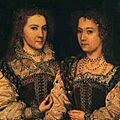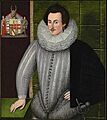Penelope Blount, Countess of Devonshire facts for kids
Quick facts for kids
Penelope Devereux
|
|
|---|---|
| Lady Rich |
|

Portrait miniature thought to be Penelope Devereux, Lady Rich, c.1590 by Nicholas Hilliard
|
|
| Born | January 1563 Chartley Castle, Staffordshire, England |
| Died | 7 July 1607 (aged 44) London, England |
| Noble family | Devereux |
| Spouse(s) | Robert Rich, 3rd Baron Rich Charles Blount, 1st Earl of Devonshire |
| Issue | Robert Rich, 2nd Earl of Warwick Henry Rich, 1st Earl of Holland Sir Charles Rich Lettice Rich Penelope Rich Essex Rich Isabel Rich Mountjoy Blount, 1st Earl of Newport Elizabeth Blount John Blount |
| Father | Walter Devereux, 1st Earl of Essex |
| Mother | Lettice Knollys |
Penelope Rich, Lady Rich, born Penelope Devereux, was an important English noblewoman. She lived from January 1563 to July 7, 1607. Penelope served as a lady-in-waiting to Anne of Denmark, who was the Queen of England. She was also the sister of Robert Devereux, 2nd Earl of Essex. Many people believe she was the inspiration for "Stella" in Sir Philip Sidney's famous poems, Astrophel and Stella.
Contents
Penelope's Early Life
Penelope Devereux was born at Chartley Castle in Staffordshire, England. She was the older daughter of Walter Devereux, 1st Earl of Essex and Lettice Knollys. Her mother, Lettice, was related to the royal family through Lady Mary Boleyn.
Her father became the Earl of Essex in 1572. When Penelope was about twelve, she met Sir Philip Sidney. He was a distant cousin of Queen Elizabeth I. They often spent time together because their families were connected. Penelope's father died in Dublin in 1576. He hoped that Philip Sidney would marry his daughter.
After her father's death, Penelope and her siblings were cared for by their relative, Henry Hastings, 3rd Earl of Huntingdon. In 1578, Penelope's widowed mother married Robert Dudley, 1st Earl of Leicester. He was a favorite of the Queen. This marriage might have changed the plans for Penelope to marry Philip Sidney.
Her First Marriage
Penelope had a strict upbringing. She lived a simple life until she was presented at the royal court in 1581. In January 1581, she arrived at court with her guardian's wife, Katherine Hastings, Countess of Huntingdon.
In March 1581, her guardian arranged for her to marry Robert Rich, 3rd Baron Rich. He later became the 1st Earl of Warwick. Penelope reportedly did not want this marriage. It was an unhappy marriage from the start. Philip Sidney remained close to her until he died in 1586.
Penelope had several children with Robert Rich:
- Lettice Rich (died 1619)
- Essex Rich
- Robert Rich, 2nd Earl of Warwick (1587–1658)
- Henry Rich, 1st Earl of Holland (1590–1649)
A Poet's Inspiration

Penelope Rich was known as one of the most beautiful women at Queen Elizabeth's court. She had golden hair and dark eyes. She was also a talented singer and dancer. She could speak French, Italian, and Spanish very well.
Many people believe Penelope inspired Philip Sidney's famous collection of poems, Astrophel and Stella. This collection includes 108 sonnets and 11 songs. It was one of the first important sonnet collections in English. Many of these poems were shared by hand before they were printed in 1591. This was five years after Sidney's death.
It is not fully known if Sidney was deeply in love with Penelope. Or if his "Stella" poems were just a popular style of writing at court.
Sidney died in 1586 from wounds he received in battle. In 1590, Penelope's brother, Robert, married Sidney's widow, Frances Walsingham. Penelope became very popular with poets and musicians during her brother's time at court in the 1590s. Many writers dedicated their works to her.
For example, the poet Richard Barnfield dedicated his first work, The Affectionate Shepherd, to Penelope Rich in 1594. Bartholomew Yong also dedicated his translation of The Seven Books of the Diana to her.
In 1586, Penelope was a godmother to the daughter of Nicholas Hilliard. He was a famous artist who painted tiny portraits for the Queen. Hilliard painted two miniatures of Lady Rich in 1589 and 1590. One was sent to James VI of Scotland (who later became King James I of England). The other was given to the French ambassador for Henry IV of France.
The composer John Dowland also wrote a piece of music called "My Lady Rich's Galliard" in her honor.
Later Life and Challenges
Penelope's marriage to Robert Rich was unhappy. By 1595, she began a relationship with Charles Blount, 1st Earl of Devonshire. Her husband, Lord Rich, did not take action while Penelope's powerful brother, the Earl of Essex, was alive.
However, Penelope became involved in her brother's political troubles. After his rebellion failed, Essex spoke against her. After he was executed in 1601, Lord Rich separated from Penelope. He also sent away her children by Charles Blount.
Charles Blount was also involved in the Essex rebellion. But Queen Elizabeth I chose to be kind to the rebels. She did not punish Penelope or Blount. Lady Rich then lived openly with Charles Blount. When James I of England became king, Blount was made the Earl of Devonshire. Lady Rich was also well-liked at court.
She was among the ladies who traveled to meet the new queen, Anne of Denmark, in 1603. Penelope then served Anne as a Lady of the Bedchamber. She danced in royal plays, called masques, at court. For example, she danced in The Masque of Indian and China Knights in 1604. She also danced in Ben Jonson's The Masque of Blackness in 1605.
In 1605, Robert Rich sought a divorce from Penelope. Penelope wanted to marry Blount and make their children legitimate. The divorce was granted. However, the requests to remarry and make their children legitimate were refused.
She married Blount in a private ceremony on December 26, 1605. This marriage went against the rules of the church. Because of this, King James banished both Penelope and Blount from court. They continued to live together until Blount's death a few months later. Charles Blount died on April 3, 1606. Penelope died on July 7, 1607.
Penelope's children with Charles Blount included:
- Penelope Rich
- Mountjoy Blount, 1st Earl of Newport (around 1597–1666)
- Charles Blount
- St. John Blount
- Isabella Blount
Images for kids
-
Frontispiece to a copy of Astrophel and Stella. The poems circulated in manuscript form before the first edition was printed in 1591. This edition included ten of Sidney's songs, a preface by Thomas Nashe and verses from other poets including Thomas Campion, Samuel Daniel and Edward de Vere, 17th Earl of Oxford.












